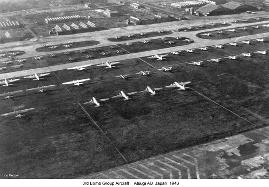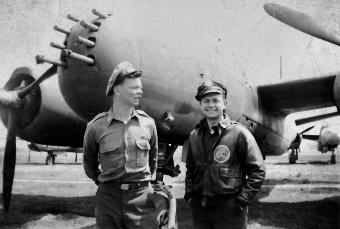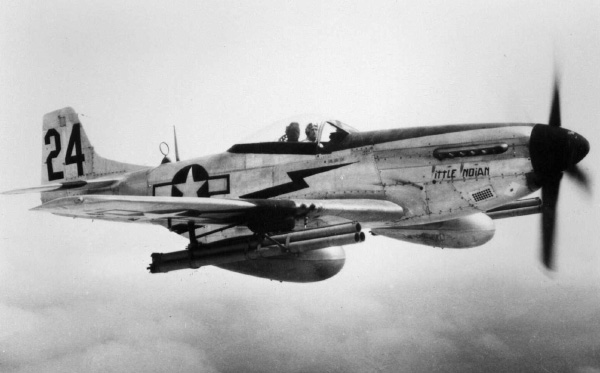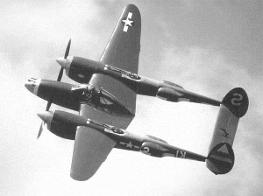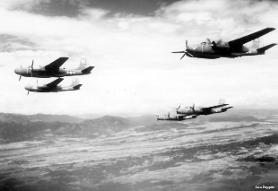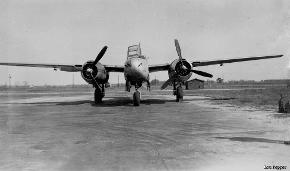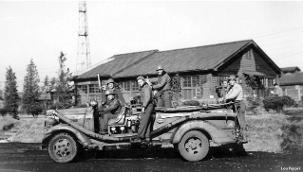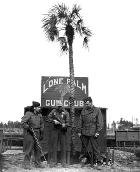Hawaii to Tokyo
or
How to Fight a War after the Other Side Surrenders
In a recent 13th Squadron INVADER there was story of the delivery of an A 26 from Tokyo to the airplane graveyard at Davis/ Monthan in Tucson. My story is the reverse of that - how I delivered an A26 from Hawaii to an airplane graveyard at Clark field on Luzon. From there I hitch hiked toYokahama and the 13th Squadron. It is a story of WW II Army Air Corps thinking.
It starts with me and a group of A-26 crews sitting at Barking Sands, Kauai, Hawaii, in 1945 awaiting orders to replace some retiring crews in the far reaches of the Pacific, namely Okinawa. We sat there until the war ended on August 15, 1945. Then in its wisdom, the Air Corps issued orders for several of us to fly planes then at Barking Sands to Tacloban, Leyte. Those of us not lucky enough to be assigned airplanes would be shipped by boat.
It didn’t seem so incongruous at the time to go west to fight a war that had ended rather than the much shorter trip east and home and out of the service. So away we went with bomb bay tanks and six guns in the nose. First stop was Oahu, then to Christmas Island (now spelled Khrismas). I wrote in a diary about the first leg of the trip and if you will excuse the just 21-year-old’s attempts at humor, and spelling, and grammar, this was what I wrote:
“August 19, 1945. Six ships leave Barking Sands. Capt Lewis, Lts. Brooks, Olson, Kushion, Holmsey, and Pepper plus two navigators, Jackson and Iden. Formation strung out enroute John Rogers-plenty weak. Landing screwed up by mountains. My final approach was a hairy 130 mph-womp. Good systems at John Rogers, Nice sack. Ham for chow. Big joke-$1 for deposit on locker key. Returned the key and they take out 50 cents for billeting and 50 cents for the in-flight lunch.
“Iden turns up sick at 3 am on the 20th necessitating a shuffle. Capt. Lewis leads with Jackson navigator. {Authors note: all ships had six guns in the nose so the navigator rode in the jump seat.) I had #2 position, Ole #3, Kushion #5, Holmsie #4 and Brooks #6. We repacked the ship-piled crap in the nose ammunition box, 2 B4s with the gunner with me. Thank God he’s short. Got seat pack chute off a navigator. Put the life raft in back. Kushion carries 2 gunners up front; had to put the life rafts in the gunner’s compartment. Great thing to have there.
“Took off at 7:55, wishy washy due to center of gravity. Mountains and Pearl Harbor screwed up the join up---nice break being #2. Climbed on course to 8,000 feet. —One hour out ran into tall cumulus. Dove to deck at 800 feet, 340 mph.
! +15 breakout and climb back –Brooks decides to do 180- engine bad. 2 + 20 flying time and 5 of 6 still going 900 of 1200 fuel remain. Spend time eating rations, drinking poor coffee. 4 hours - more weather, big hairy dive to deck again, rain on the deck, big fiddle faddle around, find a hole and climb back to 11,500 feet, use high blower for 15 minutes. Cut back to low. Lewis develops severe case of fumes in cockpit and opens bomb bay doors. Hooray, I’m in the lead. End of joke. 5 hours out, still at 11,500 feet, all of us take an hour off for lunch parked on a cloud and enjoyed the fine sandwiches in the flight lunch. (bad joke).
“Estimate 2 hours of flight left, 500 gallons remain. In Like Flynn. 28 minutes out flight right on the money. Dive down and sight Christmas coral strip, ocean and palms.”
That ended my diary for the trip but I do have my fuel logs for the rest of the flights and the time in my monthly flight record – form 5. I can’t vouch for its accuracy because no one cared much about it as the war was over and we were going home. I know the record is off on dates and perhaps even the flight times. Did I really make it to Christmas in six hours? That’s what the form 5 says.
We waited on Christmas Island for six days for an engine part to get us on our way. Other A-26s from Barking Sands caught up with us. We went from Christmas Island to Canton (now spelled Kanton on the maps). From there we flew to Tarawa. Someone called the navigator enroute and asked if he would tell us when we got to tomorrow. (Another bad joke but we were so young.) On Tarawa we saw for the first time a place that was fought over and it made us happy to be fliers. They had apparently buried our dead where they fell or marked where they fell and so there were numerous crosses right along the edge of the beach. Someone had put up a sign that said “first days advance”. It was maybe fifteen feet above high tide. The sign for the second day was maybe 20 feet further, with more crosses and Stars of David in between. When I asked where the Japanese were buried they said under the airstrip. There was a tank rusting some distance from shore in the shallow lagoon.
From there we flew to Eniwetok. The airstrip was right along the water. The sea wall was made of a lot of wrecked airplanes. They were mostly navy planes that were just bulldozed off the strip into the ocean. That was our welcome when we landed. Maybe we were on the wrong side of the island, but we didn’t see any graves. From there we flew to Guam and again a seawall of wrecked aircraft. There was a very heavily guarded compound surrounded by barbwire entanglements and a guarded gate. On inquiry we learned that it was the nurse’s quarters. We got to spend few nights on Guam and got to drink at the navy officers club. Those poor chaps would come in from their ships for their two hours at the club and Lord knows how many days without a drink. We were somewhat appalled at how rapidly they got drunk. The Air Corps was much more gracious and refined in its drinking you will be happy to know. We got drunk gradually.
While MacArthur was signing the treaty on the Missouri we flew from Guam to Tacloban, Leyte. There the airstrip, with a steel mat runway, was right along the water and its north end started at waters edge. It was on a small peninsula that was at the far northeast edge of Leyte just across the straits from Samar. Tacloban was to the west, across the bay from the strip. Greeting all people that landed there was a C 46 which stood on its wheels in the water, 50 or so yards short of the runway. Its right engine was feathered. (Don’t undershoot!) When we parked, the follow me jeep driver told us that the clocks would be stolen that night and also the morphine in the first aid kits, so if we wanted them we had better take them right away. I took my clock. That was a little different than the Ron Rodda’s experience in Tucson as I signed no papers and was advised to take the clock as a souvenir.
We found a visiting officer's quarters and moved in. Our orders ended there. The group we were to join had been disbanded. After a few days we found that the ATC had moved out and we moved into the bamboo shacks they had left empty. They were choice water front locations out by the airstrip and were actually built over the waters of Tacloban bay. Ah splendor! And with house boys mind you. It was a little moist on Leyte. The leather bill of my cap grew a lot of green mold while hanging on a nail.
We found that there were all sorts of airplanes at the field. P 51s, P 38s, P 63s, A 20s, A 26s, some transports, and a variety of other heavy and light aircraft. Most of the people had left and the good mechanics in particular. The Ops people said they would appreciate it if we would fly some of the planes up to Clark field on Luzon. They had a C 47 that would bring us back at the end of the day. Our gunners were the primary mechanics for us. So we flew A-26s and A-20s up there and what a busy place Clark was. Air craft were being brought in from everywhere around and the taxi instructions were like -- turn right off the runway and continue beyond the B 24s then turn right and go past the P 51,s and the P 38s and turn left and taxi to where the A 26s are parked and park at the end of the row. It seemed like several miles out in the tules from the strip. A jeep would eventually come by and take you back to operations.
Of course we could fly anything we wanted and a couple guys were off in the P-51s almost immediately. If my memory is correct, one poor chap hit a mountain so that dampened our enthusiasm for single engine fighters. I wanted to fly a P-63 but we couldn’t find any one there who had ever flown one. We did discover a P-38 pilot and he stood on the wing and “checked out” Captain Lewis, one of our guys. I flew an A-20 for the first time, which was very easy after the B-25s B-26s and A-26s I had flown.
I couldn’t wait to try a P-38. Well, our Capt. Lewis, who had flown one once crouched on the wing and told me about how to start the engines and the main tools in the cockpit and then said there was a lot of other stuff that he wasn’t too sure about but to “try to keep all the gauges in the green.” I was ready. My, those Allison in-lines sound pretty when you taxi. I waved casually to a transport pilot that I knew as I taxied by. When I ran up the right engine I found I could not hold the airplane with the brakes so I made a complete stupid circle there at the end of the runway. Then I ran up the left and made a circle the other way. So much for being cool.
The mags were just fine. The engines sounded just lovely at full power. Just after lift off as I approached the C-46 a wing dropped a bit and I over corrected and then over corrected the other way and I must have looked like I was trying to stay airborne by flapping the wings. No one had told me it had aileron boost and I finally figured out how sensitive it was. I climbed to 10,000 feet and flew a landing pattern, even to wheels down, and near stalling speed. I was that cautious. Then I goofed a round a bit and landed without incident.
It was strange and wondrous time over there. I was in operations one day telling them that I was going to fly an A-26 in the area. I could have filed a flight plan for Paris and the Ops officer would have probably ask if he could go along, it was that loose. That day a slightly built second lieutenant in a brand new khaki uniform with new shiny wings and gold bars ask if he could go up with me. I told him I wasn’t going anywhere but he was welcome. As we drove to the plane I ask him what outfit he was in and he answered something like “the 9th pursuit”. I ask where that was based and he said it had been at Clark field in 1941 and that he had been a prisoner of war. After they flew him out he passed the physical because his body type could live OK on prison food.
As a side note - there was special place set up at an airfield near Manila where they first brought prisoners of war, screened them, and took care of their needs. Then they shipped them home or to hospitals in the states. I was there once and it was the very best we could possibly have for them, really really nice.
Instead of taking the flight home this POW lieutenant asked if he could stay a while and look around. He told me he didn’t expect to get back that way again so he thought he would like to see something of the Philippines. I showed him Samar and Ormoc bay and the big sailing boats with families living on them. There wasn’t a whole lot else to see. I thanked him and wished him well when we got back.
For a month or so we flew up to Clark quite often. Then we decided that a whole bunch of us should fly P-38s to Clark. My log says it was the 13th of October. This was my second flight in ‘38s. When nearly there I felt a thump and saw the hydraulic pressure needle leave the green. It drove like a truck. The paint with the instructions on how to crank the wheels down was pretty much scratched off, but one of the guys flying up with me read the instructions to me and I got the wheels down. But then I worried if I would go off the end of the runway. When I called the tower and told them my problem, they laconically told me not to worry because the brakes were independent of the hydraulic system on a P-38, just like a car’s brakes. I landed with no problem and when parked another of our guys was in the jeep that came to pick me up. I vividly described my harrowing experience. As we drove back around the runway I noticed a P-38 in a ditch on its nose. It was his. He had lost an engine on the final and couldn’t hold it on the runway. He was pleased that he had missed the first ditch. The jeep driver had picked him up when coming out to get me. When we got to operations there was a large sadness as one of our chaps had tried to switch fuel tanks and shut off both engines and was killed. He was the only one of us who was married with children.
When we got back to Tacloban a small conference determined that we had enough of the ferrying and it was time to find the Fifth Air Force Headquarters and let them know we were over there, then see where they would send us. We arranged a ride on a merchant ship headed for Yokohama, drew beer rations for 5 squadrons and got aboard. (Boy, was there ever a huge beer dump on Leyte- -- Bud and Schlitz in export bottles if you looked hard enough.) It was a nice trip to Yokohama, but a little rough as there was typhoon somewhere. We also had a guy get acute appendicitis. We turned toward a hospital ship and they turned toward us and about a half day later we off loaded him. After that, at every meal in the officers mess, the first mate and the Captain argued about our ETA to Yokohama .They were about 24 hours apart. I was glad we weren’t flying with them.
The Fifth was headquartered at Tachikawa so we caught the train up from Yokohama. They sent most of us to the 3rd Attack group at Atsugi and me on to the 13th Squadron. We were all just waiting our turn to go home. All of the old 3rd Attack group had pretty much gone home and only guys that had flown just a few missions were left. The 13th had rented a home in the mountains above Myionoshita so we spent a lot of weekends there sharing high tea with some people that had been interned up there by the Japanese because the wives were American and the husbands Austrian. High tea consisted of Suntorys scotch type whiskey served in their fine crystal liqueur glasses, plus their black bread (which we enjoyed) and our white bread (which they ate) and canned cheese. It was a very civilized affair.
The 13th had some interesting visitors that winter. Gen. Pete Quesada and Gen F. Trubee Davison stopped in one evening to see where Gen. Davison’s son lived. His son was
Endicott P. "Cotty" Davison , later captain of the Yale football team. One of Cotty’s friends from Groton, who had been on Ambassador Joe Grew’s staff in Tokyo on Dec 7, 1941 spent a weekend with us in the house in the mountains and we heard about what it was like in the American embassy in Tokyo in 1941. It was a fascinating story.
Then too Atsugi was where the VIPs landed so when ever we saw a big bunch of staff cars go by we would go down to the strip to see who was coming in. MacArthur met Secretary of War Patterson there and also Herbert Hoover and Ike. They once called ahead to the base headquarters to have a group of ‘soldiers’ be an honor guard. It was the sorriest looking bunch you could imagine. I don’t think anyone at Atsugi had stood at attention for several months at least, let alone have a full proper uniform. One of the colonels with Macarthur got out and told them they were dismissed. They all waited around to see who was coming and even looked sorrier just standing there. There wasn’t much in formality at Atsugi in late ’45 until at least August of ‘46. No one saluted much and the uniforms were a mixed bag all over the place. One time when McArthur and his guest and all his generals left in the staff cars they forgot a three star general. I have forgotten who it was but he had a sense of humor. He was holding a paper bag so he said to us, standing there in a circle staring at him, that at least he had kept his lunch. We offered him a ride in a jeep to try to catch them and off he went hightailing it down the road.
Other than that we drank at the group’s club and amused ourselves anyway we could. I climbed Fuji, saw the war crimes trials, the Japanese Diet and tried most of the golf courses in the area. (They had made me the athletic and recreation officer.) I built a tennis court that I called “Fountain Hills Raquette Club”. Some one built a skeet range called “Lone Palm Gun Club”. We were pretty much devoid of mechanics except our gunners until they went home. We had pilots doing regular maintenance. We had to have enough ships to get our flying time. In time things improved as the pilot mechanics got better at maintenance and we could get maybe ten planes in the air.
Atsugi had a P-38 squadron and some PBYs along with our A-26s, some transports and one B-24 which we had attached to the group as a weather plane, but it was used to fly Seagram’s VO up from Manila to supplement the Suntorys and the Japanese beer. The P-38 guys thought they were really hot. The biggest laugh was when we did a fly over at the dedication of a hospital in Osaka. On the way back a very serious voice came over the radio “This is Col Randall of 5th Air Force Headquarters.” He said they had graded the units in the fly over and the A-26s were first, second the C-46s, third the PBYs and last the P-38s. We all recognized the voice as that of our Lt Rogers B. Holms, better known as “Tiger”. There were a lot of snorts on the radio after that announcement. Any of you from Jacksonville may know “Tiger”. He was very much alive and the same as always a couple years ago. He led a demonstration flight for the benefit of the new comers as his farewell to Atsugi. I enclose two pictures of that flight. Yes, the ships flying in that one formation all have one engine feathered. Bet you never saw that before. Then, when Tiger flunked the new CO on an instrument check, it was time for us to go home and a boat came.
Me? I finally got home, finished school and practiced law for 30 years then spent 10 years as CEO of Washington Mutual Bank. I am now in frequent email contact with three members of my class, which was 44G out of Brooks Field. Now ain’t that fun.
Lou Pepper
